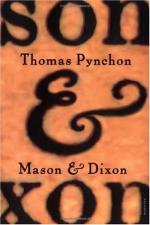|
This section contains 823 words (approx. 3 pages at 300 words per page) |

|
Pynchon's postmodern style blends tragedy and satire, fiction and nonfiction, fantasy and realism, historical characters and hundreds of secondary characters, unresolved conflicts, lengthy sentences, archaic language and spelling, dialogue without tag lines, stream-of-consciousness flashbacks, poems and songs, and anachronisms.
First-person narrator, Rev'd Wicks Cherrycoke shifts to a third-person omniscient point of view. He claims that his omniscience is the result of close association with Mason and Dixon in Capetown and on the Visto. However, his twin nephews Pitt and Pliny protest when his tales become too fantastic. "How could you possibly know that?" they ask.
The plot moves as slowly as a sailboat held back by unfavorable winds and ocean currents. The stream-of-consciousness technique reveals Mason's and Dixon's thoughts, emotions, adolescent experiences and family conflicts, and their past experiences as astronomer and surveyor.
Pynchon's introduction of new secondary characters in every chapter also slows the plot. They interact...
|
This section contains 823 words (approx. 3 pages at 300 words per page) |

|




